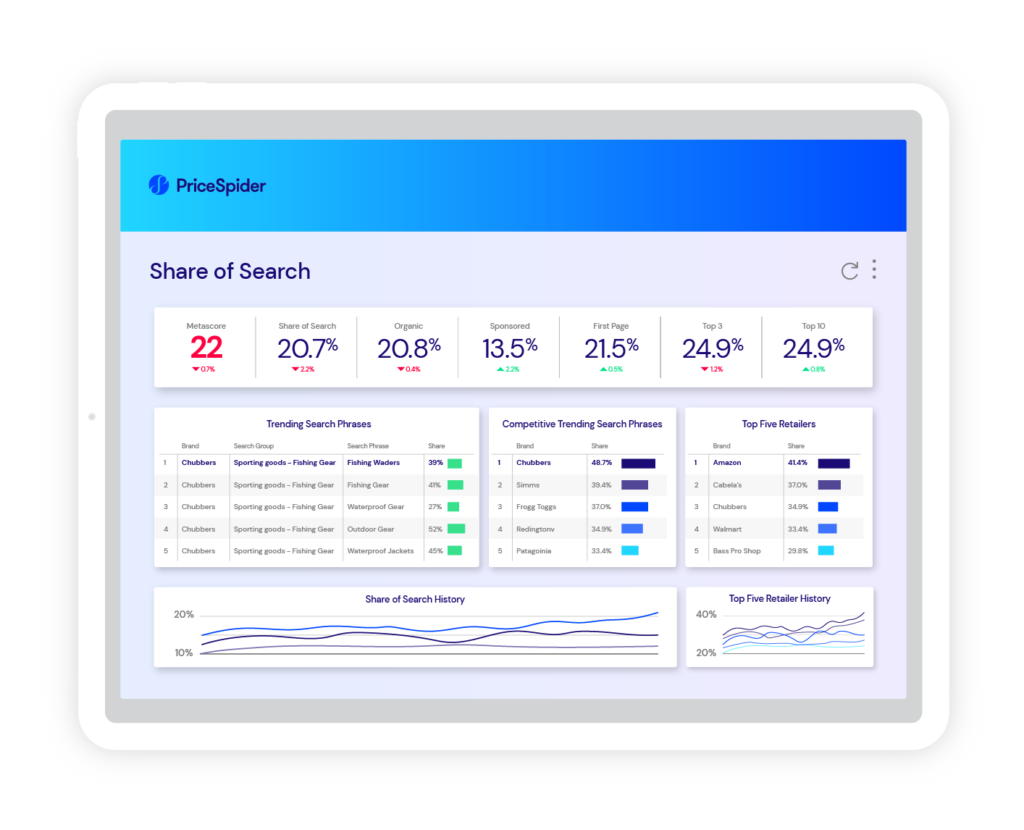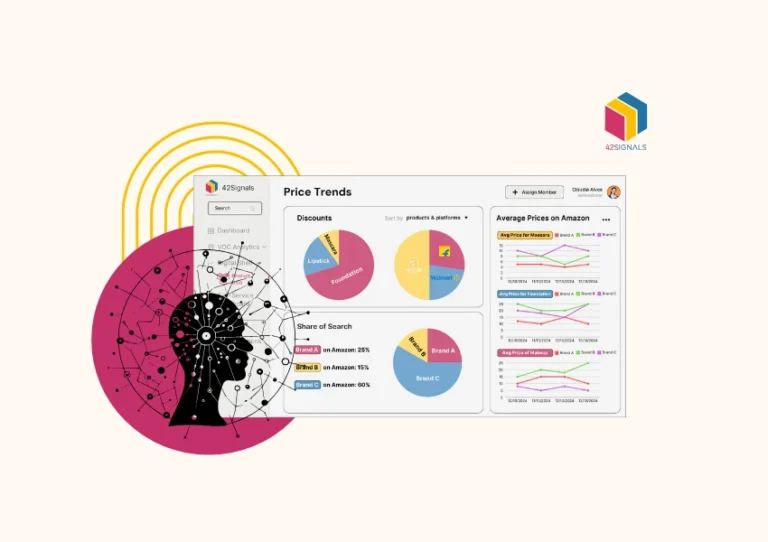In e-commerce, success often hinges on your ability to accurately forecast sales and optimize inventory. Failing to do so can result in missed opportunities, excess inventory costs, and dissatisfied customers. To tackle these challenges and thrive in the competitive e-commerce landscape, businesses are increasingly turning to predictive analytics. However, there’s a new player in town, a metric that’s changing the game: Share of Search.
Understanding Predictive Analytics in E-commerce
Predictive analytics involves the utilization of historical data, statistical algorithms, and machine learning techniques to discern forthcoming trends and behaviors. Within the realm of e-commerce, this entails the utilization of data to anticipate customer demand, forecast sales patterns, and determine inventory needs.
By using predictive analytics, e-commerce businesses can:
- Forecast sales accurately
- Optimize inventory levels
- Identify potential demand fluctuations
- Improve marketing and promotional strategies
- Enhance customer experience and satisfaction

Image Source: Sam Solutions
Share of Search: A Key Performance Indicator
Share of Search is a concept that’s recently gained prominence, particularly in the digital marketing and e-commerce realms. Unlike traditional metrics like Share of Voice, Share of Search provides a more accurate picture of your brand’s presence in the digital landscape. It measures the share of online search queries related to your brand compared to your competitors.
The relationship between Share of Search and customer demand is straightforward. When potential customers search for products or services in your industry, a higher percentage of this metric indicates a greater share of the audience’s attention. Businesses with a strong share of searches can leverage this attention to drive sales.

Image Source: Dataweave
Leveraging Predictive Analytics for Sales Forecasting
To harness the power of predictive analytics, you’ll need robust data sources and tools. These include historical sales data, customer behavior data, market trends, and analytics platforms. By utilizing these resources, you can create accurate sales forecasts, thereby:
- Anticipating Demand: Predictive models can forecast demand, helping you allocate resources efficiently.
- Optimizing Marketing: With sales predictions, marketing campaigns can be tailored to maximize impact.
- Streamlining Inventory: Inventory can be managed with precision, reducing carrying costs.
Optimizing Product Availability with Predictive Analytics
One of the significant challenges for e-commerce businesses is maintaining proper stock levels to meet customer demand while minimizing inventory holding costs. Predictive analytics can play a vital role in optimizing product availability.
Using predictive analytics models, businesses can identify demand patterns, detect high-demand periods, and adjust their inventory accordingly. By accurately forecasting sales, businesses can avoid stock-outs and overstock situations, which can lead to lost revenue and increased costs.
Predictive analytics can also help businesses identify slow-moving products or underperforming SKUs. By identifying these products early on, businesses can take proactive measures such as adjusting pricing, launching marketing campaigns, or liquidating inventory to prevent losses.
Measuring and Improving Share of Search
To improve sales forecasting accuracy, e-commerce businesses should focus on monitoring and improving their share metrics. This can be accomplished with:

Image Source: PriceSpider
1. Search Engine Optimization (SEO)
E-commerce businesses can enhance their visibility in search engine results by optimizing website content, meta tags, and keywords. This can lead to increased organic traffic and a higher share.
2. Paid Search Advertising
Investing in targeted paid search campaigns can help increase brand visibility and attract more customers. By appearing in the top search results, businesses can capture a larger share of queries and potential customer interest.
3. Competitive Analysis
Monitoring competitors’ share of searches can provide valuable insights into market trends and industry dynamics. By understanding competitor strategies, e-commerce businesses can adapt and make proactive adjustments to maintain or increase their own market share.
4. Customer Engagement and Loyalty Programs
Implementing customer engagement strategies and loyalty programs can help increase brand affinity and encourage repeat purchases. This can lead to a higher percentage of searches as satisfied customers are more likely to search for and recommend a brand or product.
The power of predictive analytics and the emergence of Share of Search as a critical metric are transforming e-commerce. By utilizing predictive analytics, businesses can forecast sales and optimize inventory effectively.
Ready to say goodbye to the guesswork in sales forecasting?
Explore how 42Signals can elevate your e-commerce game with predictive analytics and elevate your Share of Search.
Our platform provides concise and actionable insights that help businesses improve rankings and searches in their category and concerning their competitors.
Interested to try it out? Sign up for our free trial today.
Frequently Asked Questions on Predictive Analytics
What is meant by predictive analytics?
Predictive analytics is the use of historical data, statistical algorithms, and machine learning techniques to forecast future outcomes or behaviors.
It answers the question:
👉 “What is likely to happen next?”
Businesses use predictive analytics to:
- Forecast customer demand
- Identify churn risks
- Optimize inventory
- Detect fraud
- Personalize marketing campaigns
In short, predictive analytics helps organizations make proactive, data-backed decisions rather than reacting after the fact.
What are the 4 predictive analytics?
While predictive analytics is a broad concept, it commonly breaks down into four practical techniques:
- Predictive Modeling – Uses historical data to train models that predict outcomes (e.g., who is likely to buy or churn).
- Machine Learning – Algorithms that automatically improve predictions as more data becomes available.
- Regression Analysis – Identifies the relationship between variables to forecast a numeric outcome (e.g., future sales).
- Classification – Assigns data into categories (e.g., high-risk vs. low-risk customers, responders vs. non-responders).
These methods are often combined in modern analytics platforms to deliver more accurate forecasts.
What are examples of predictive analytics?
Predictive analytics is used across industries. Some real-world examples include:
- Retail & E-commerce:
- Recommending products based on browsing and purchase historyForecasting seasonal inventory needs
- Predicting credit default risk Fraud detection in real-time transactions
- Predicting patient readmissions or disease outbreaks
- Segmenting audiences based on likelihood to convertIdentifying customers at risk of churn and automating retention offers
What are the 4 types of data analytics?
The 4 types of data analytics represent different stages of understanding and action from data:
- Descriptive Analytics – What happened?
- Analyzes past data to provide insight into trends and outcomes.
- Example: Monthly sales reports.
- Diagnostic Analytics – Why did it happen?
- Digs deeper into data to uncover root causes or contributing factors.
- Example: Analyzing why website traffic dropped.
- Predictive Analytics – What is likely to happen?
- Uses modeling and forecasting to anticipate outcomes.
- Example: Predicting customer churn or demand spikes.
- Prescriptive Analytics – What should we do next?
- Recommends actions based on predictions and simulations.
- Example: Dynamic pricing suggestions or product recommendations.
These four types build on one another to deliver a full-picture analytics strategy.





